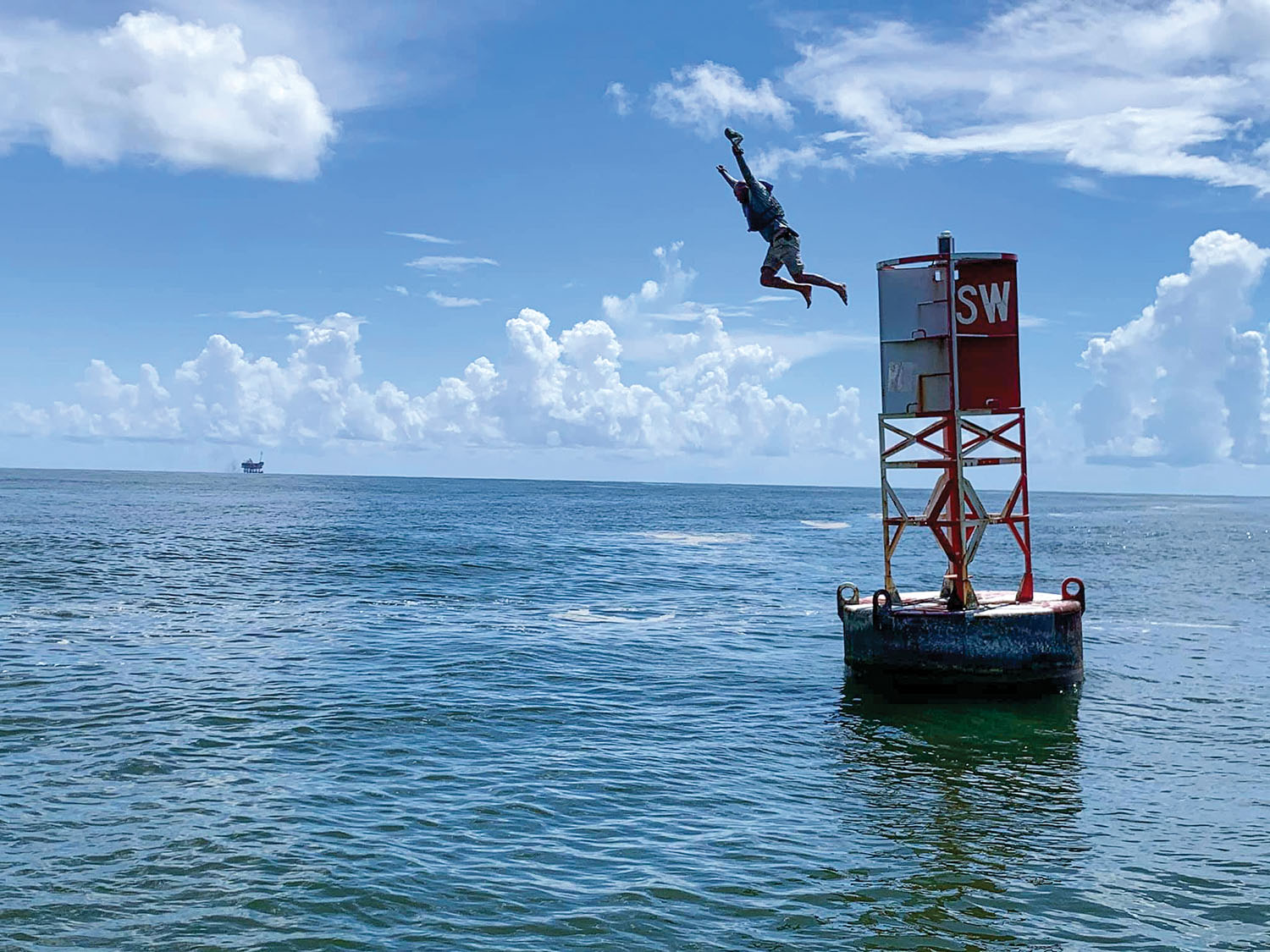Plenty of people have a lifelong dream, but few go on to achieve it.
As of August 8, Joey Cargol, a Gretna, La., resident and river pilot known on the Mississippi River as “Crescent 50,” did just that when he reached the sea buoy at the mouth of the Mississippi River Ship Channel aboard his 73-year-old canoe. Scaling the red and white buoy and jumping into the salty Gulf of Mexico water, Cargol that day completed a 70-day journey paddling the entire Mississippi River, from its headwaters in Lake Itasca, Minn., to the sea.
Cargol is a pilot with the Crescent River Port Pilots Association, the group that guides oceangoing ships from Pilottown, a tiny community just above Head of Passes, to New Orleans. At the age of 10, the Belle Chasse, La., native made up his mind to someday paddle the entire length of the Mississippi River. Cargol said the river has always been part of who he is.
“My grandfather worked on the river, and for me, as a small child growing up, this was everything,” Cargol said in an interview conducted as he paddled past Plaquemine, La. “The Mississippi River was something I thought of every day.”
While Cargol can definitively remember conceiving the trip as a 10-year-old, the idea, perhaps, was planted in his mind even earlier when he attended the Louisiana World Exposition in 1984 and saw the Old Man River exhibit.
“I was probably four years old at the time,” he said. “And at 10, I had designed this whole trip. I planned on it, and it was in my head that I was going to paddle the Mississippi River.”
He carried the dream with him to Texas A&M, where his roommates, many of whom are now fellow river pilots, would tell him to “quit telling tall tales, it’ll never happen,” Cargol said. Then about 20 years ago, he bought the wooden canoe he eventually used for the trip. Cargol’s wife, Katie, said before they got married he made sure she knew that he’d someday accomplish his dream of paddling the entire river. Still, the years kept passing by.
“The dream stayed alive inside of me, but the reality of making it happen just never came to fruition,” he said.
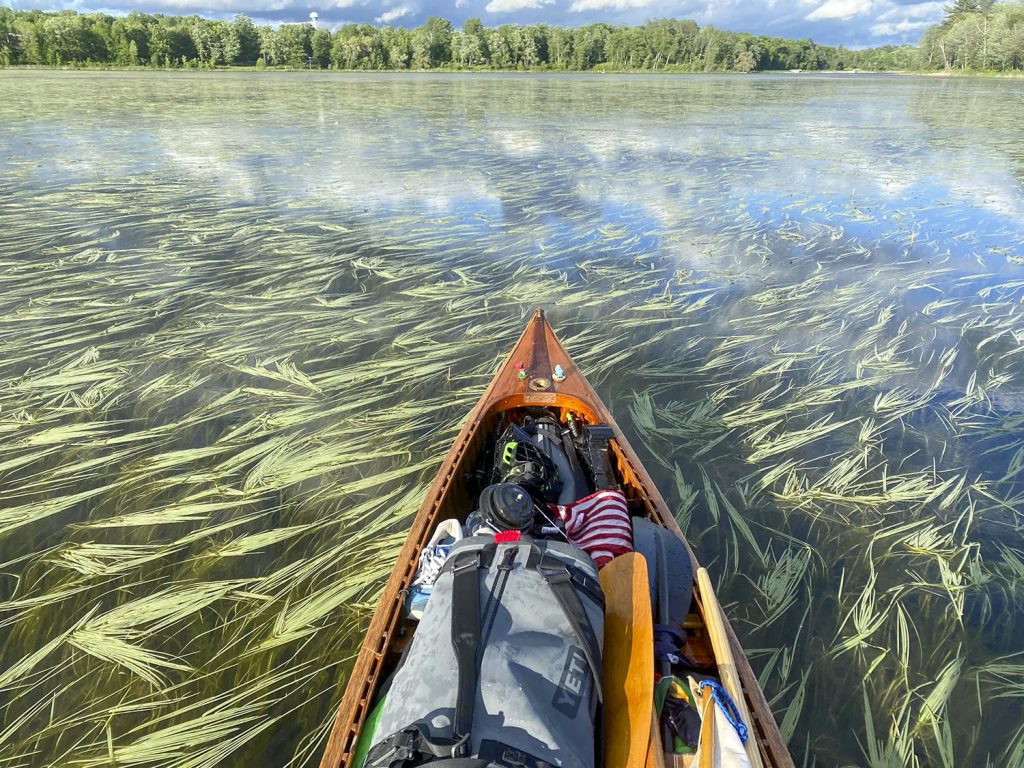
Then, about a year ago, Cargol resolved to accomplish his dream in 2020, with the plan to name the boat “Rocinante” after Don Quixote’s horse. He also planned to add a scientific element by taking water samples along the way. With shutdowns from COVID-19, though, the university partnerships needed for the research element proved impossible. Then, a couple months before he left, he rediscovered the notebook where he’d named the boat and sketched out the trip when he was 10.
“In my notebook was ‘The Lil Injun That Could,’” Cargol said. “I’d drawn a picture of it, with the name and everything. I thought, ‘I can’t not do this.’ So I pretty much threw away all the plans I’d made [as an adult] and just did it with what I planned when I was 10.
“I wouldn’t change a thing,” he added, “because it really was that much more meaningful to me, and there was a lot more adventure to it.”
The Upper River
To get his canoe from the New Orleans area to Minnesota, Cargol rented a moving van and headed north. He set out from the southern shore of Lake Itasca May 31 and headed, ironically, north toward the headwaters of the Mississippi River. En route to the headwaters, Cargol stopped at Schoolcraft Island, named for Henry Schoolcraft, who is credited with discovering and mapping the true headwaters of the Mississippi at Lake Itasca. Schoolcraft coined the name Itasca by combining the Latin words veritas (true) and caput (head). While on Schoolcraft Island, Cargol left a memento or time capsule for his daughter and three sons.
“I buried an aluminum can that contains a treasure and a note,” Cargol said. “If they ever decide to do this, they can start there and find the note I left for them. Maybe that will inspire them to follow their old man’s path and find a fondness and love for the river.”
Cargol did add a word of caution for anyone visiting Schoolcraft Island.
“It’s covered in ticks,” he said.
Cargol said one thing that surprised him about the upper reaches of the Mississippi River was the geography. In spots, as the river snakes its way northward through Minnesota, it’s quite swampy, Cargol said, much like the South Louisiana landscape.
“There are marshes that remind you of Empire, La.,” Cargol said. “I grew up in South Louisiana, and I had no idea the beginning of the Mississippi River would feel so much like the very end. Take away the rocks, and the little mud sloughs and trenasses really do feel like South Louisiana.”
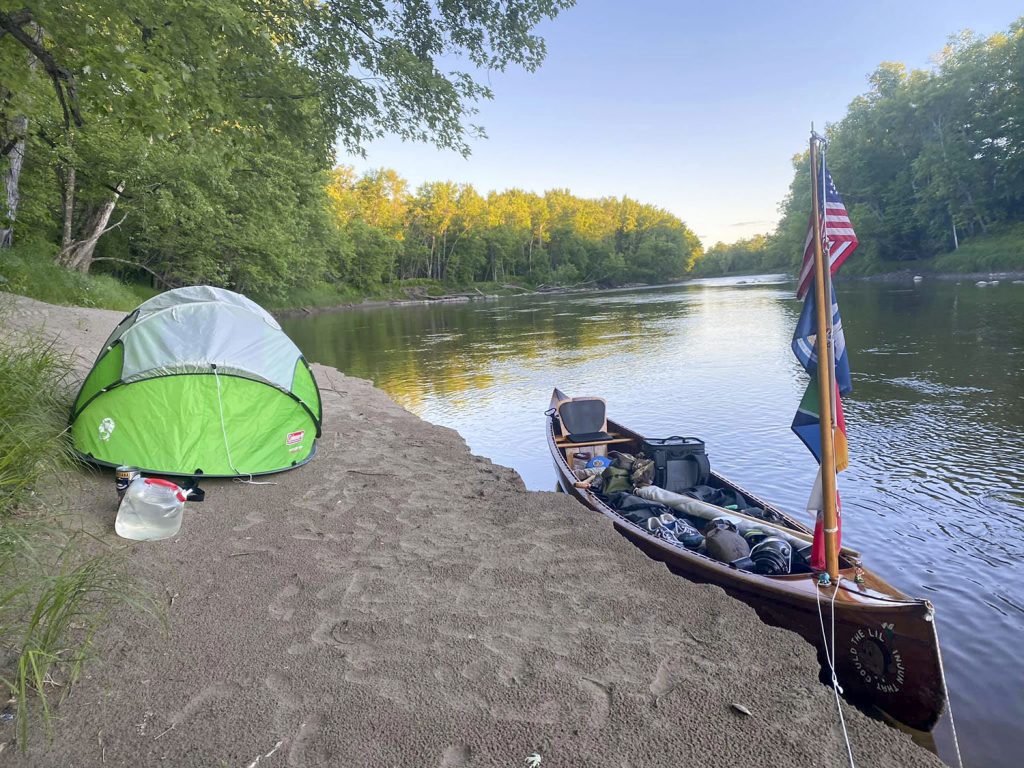
Those first days, struggling to paddle across windy lakes and dragging his canoe through mud and over rocky patches, were a major challenge for Cargol, who had to actually pitch his tent in the swamp at times early in the trip. Following his first couple days past the headwaters at Lake Itasca State Park, Cargol wrote, “Very low water, mere inches most of the day, and as Fats Domino would say, I felt like I was walking to New Orleans pulling my canoe behind me.” Cargol’s journal is posted on a Facebook page titled “Expedition H2020.”
The early days were also rough on Cargol’s canoe, which he had to repeatedly patch along the way.
But while the lakes region was physically and emotionally taxing, Cargol was equally struck by the beauty of the landscape and wildlife.
“The whole time you’re engulfed in nature—bears, wolves, eagles, deer,” he said. “Think of it, and it’s out there. You’re so far removed from civilization that these animals don’t even suspect you or have any kind of fear of you. The deer will walk up within feet of you and drink from the river as you paddle by, looking at you and just kind of wondering.”
Near Gamblers Point, Minn., close to where the Mississippi finally turns south, Cargol paddled through the remnants of Tropical Storm Cristobal. As Cargol paddled toward Grand Rapids, Minn., on June 10, he marked the second anniversary since his father died. Cargol said his dad had talked of accompanying him on his long-planned canoe trip.
“He was unable to come, but I brought a pair of his water shoes and that’s kind of him coming with me,” he said.
The following day, June 11, Cargol posted the Bible verse, “I can do all things through Christ who strengthens me,” after having a particularly difficult night along the river.
“So last night around 0130 I felt something wet in my sleeping bag,” he wrote. “Reached down and found a wet gummy bear. Nope, I’m kidding. It was a leech. … Got up and shook my sleeping bag to find two more leeches in my bag. Just imagine how easy it was to fall back asleep.”
Help And Hazard Along The Way
Soon enough, the swamps, brooks and streams of the upper reaches of the Mississippi gave way to bluffs and cliffs as Cargol paddled through Iowa, Wisconsin, Illinois and beyond, with the river steadily growing in size. And as the days marched on, Cargol met all kinds of people along the way.
He met an Iraq war veteran who was paddling the Mississippi River to raise money for PAD, an organization that gives service dogs to wounded veterans. Cargol had strangers happen by over and over to help out just in his times of need. In Iowa, where his grandmother was from, Cargol was able to meet a group of cousins for the first time. In Memphis, Cargol’s family traveled up to meet him for a day of rest. On the last day of July, near St. Francisville, La., the wind pushed Cargol up to the bank near Como Plantation, where a volunteer group called the Mississippi Nailbenders was building cabins for a Christian retreat. The group welcomed him with food, a bed and a shower, much like another church group did earlier in his journey. Cargol took a day off and helped in the construction effort.
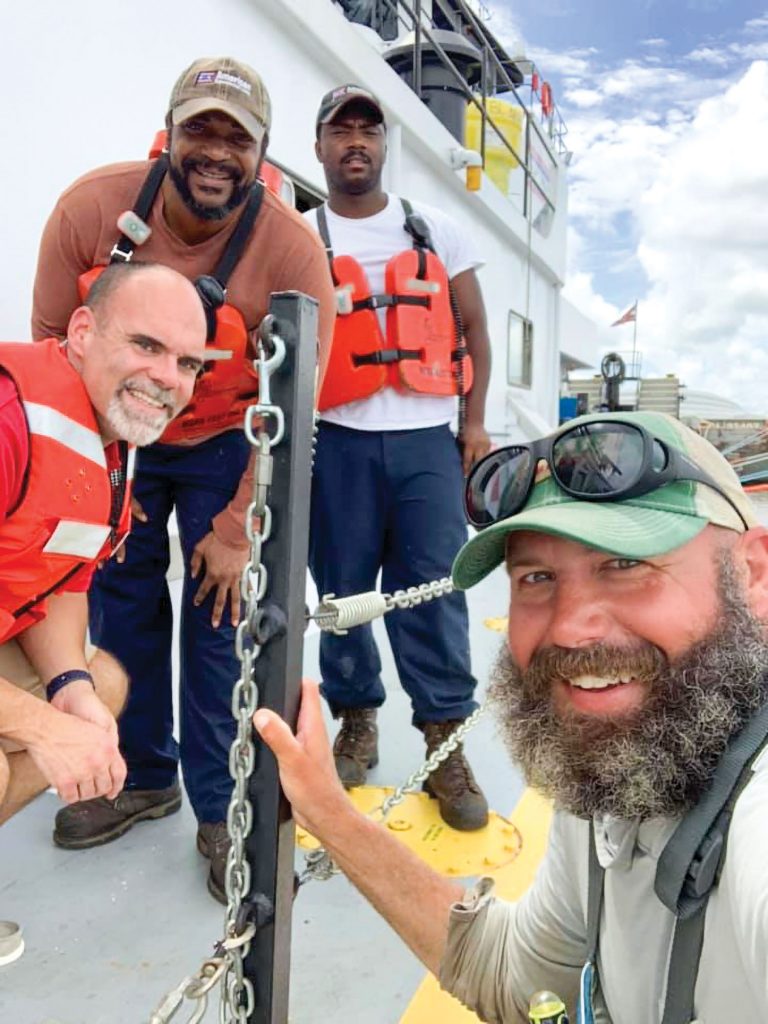
The traveling wasn’t easy. Near Warsaw, Ill., Cargol awoke in the middle of the night to find his canoe overturned by waves and his gear floating downstream. Near Trail of Tears State Park in Jackson, Mo., Cargol unknowingly camped right beside a busy railroad. He posted a middle-of-the-night video with a train roaring past his tent. Not far above Cape Girardeau, Cargol had a close call with a boil and whirlpool in the river at Fountain Bluff. The whirlpool, Cargol wrote, grew to at least six feet wide and four feet deep.
“The only thing that saved me was pure luck,” he wrote. “The canoe caught the gyre on its beam instead of its bow, for if my bow had gone first I would have surely plunged into its depths and may still be down there looking for Davy Jones’s locker. It shot me spinning off, unbalanced and completely discombobulated to my surroundings.”
From St. Paul, Minn., all the way to the end of his journey, Cargol was met with camaraderie and support from his fellow mariners on the river.
“Just south of St. Paul, I had a tow that said, ‘I recognize that voice, but I can’t place the number,’ he said. “We started talking, and I said, ‘Crescent 50.’ He said, ‘I knew it. Rarely do you see a canoer with a radio, much less one that knows exactly what he’s talking about.’
“He went up and down the river telling everyone that Crescent 50 was coming down,” Cargol added. “It’s been kind of laughable to have a bunch of these guys call me Crescent 50 on the radio. It warms me up a bit, makes me feel like I’m with guys who understand me. It’s a brotherhood.”
Whether it was making passing arrangements or crews offering him supplies, Cargol said he appreciates his towboating colleagues. Paddling the river in a canoe has also given the river pilot more of an understanding and appreciation for towboat crews on the river.
“I couldn’t do my job without them, and they couldn’t do their job if we didn’t move the ships,” he said, “so it’s truly been great.”
Back Home In Louisiana
On the morning of July 24, Cargol finally made it back to his home state after almost two months paddling on and sleeping beside the Mississippi River. It marked the last chapter of his journey, and the excitement of the homecoming helped power him the rest of the way.
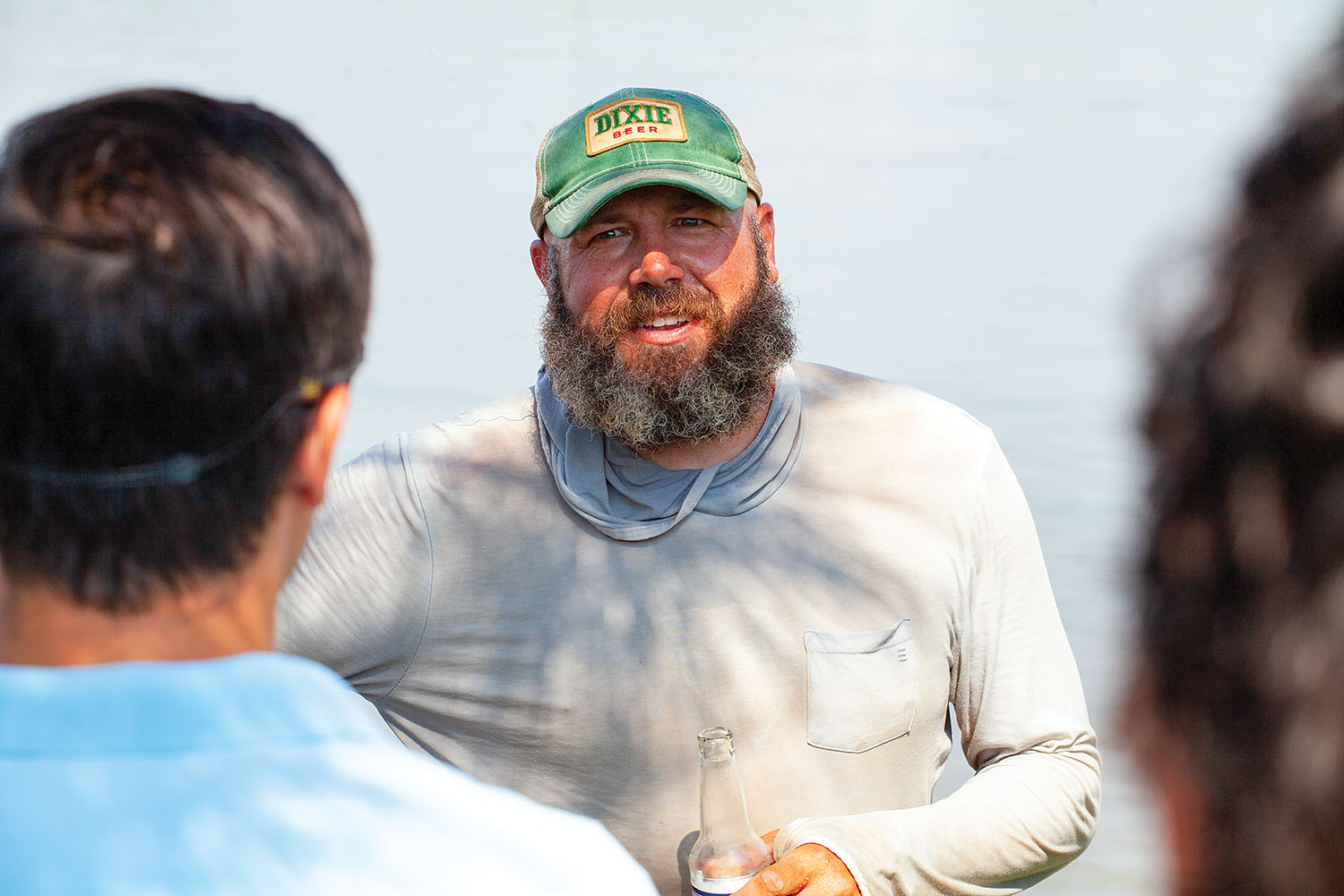
“In all my travels and everywhere I’ve gone, there’s only one place that I call home,” he said from his canoe that morning. “It’s the great state of Louisiana. I’m 53 or 54 days into this trip, and I wanted to share this with y’all, because it’s very special to me. I’m coming home to Louisiana.
“I love this state,” Cargol continued. “From the cotton fields of North Louisiana, to the rice paddies of the southwest, the hardwoods of Central Louisiana, the sugarcane fields of the river parishes and the marshes and swamps of South Louisiana, there’s not a part of this state that I do not love. … This is home, and God bless it.”
By August 5, Cargol paddled around Carrollton Bend, stopping to meet friends and family on the east bank at a park called The Fly. Later that day, he stopped again in Gretna and in Belle Chasse.
By August 7, Cargol had traveled the entirety of the Crescent Pilots’ area of operation between New Orleans and Pilottown. And then on August 8, Cargol pointed his canoe toward Southwest Pass and set out on the last day of his journey.
“Nobody goes through Southwest Pass, but being a pilot, I’d be remiss if I didn’t do Southwest Pass and out to the sea buoy,” he said.
And with friends and family following him alongside in recreational boats and aloft in a seaplane, Cargol reached the sea buoy marking the start of the Mississippi River Ship Channel.
“With my family and friends cheering me on, I climbed the buoy and rested a minute,” he wrote in his last journal entry. “With my journey complete to my satisfaction, I let it sink in. There was only one thing left to do. Jump in the Gulf, and I did. Surrounded by dolphins, I jumped. The warm waters engulfed me and the salty taste struck my tongue. This was no longer the cold muddy river I had spent so much time on, it was something very different.”
Caption for top photo: Joey Cargol finished his journey with a leap from the sea buoy that marks the end of the river. (Photo courtesy of Joey Cargol)


